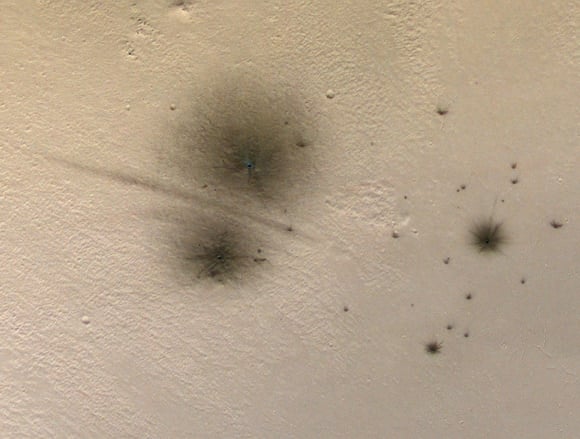[/caption] Incoming! Hundreds of small objects, mostly asteroid fragments, impact Mars every year. Sometimes, like on Earth, objects break up in the Martian atmosphere. But Mars' atmosphere is much thinner than Earth's, meaning more stuff hits the ground on the Red Planet. If a bolide breaks apart and but doesn't disintegrate, the result can be a cluster of craters. The image here is an example of that, with this group of recently made small impact craters. Although small Martian crater clusters are common, this example is unusual because there is a dark line between the two largest craters. The HiRISE scientists hypothesize that atmospheric breakup created two nearly equal-size objects that impacted close together in space and time so the air blasts interacted with each other to disturb the dust along this line. Wow!
The impact occurred sometime between May 2003 and September 2007. A dark spot is not present in the previous image of this location with sufficient resolution to have detected it, acquired by the visible THEMIS camera on Mars Odyssey in May 2003. Check out the
THEMIS site, where you can find images by clicking on a map of Mars.
This impact was first discovered as a dark spot in an image taken by the Mars Reconnaissance Orbiter's CTX (Context) Imager acquired in March 2008, but later found to be partly visible at the very edge of a CTX image acquired in September 2007. The CTX team has been discovering many new impact events on Mars, and then they request HiRISE follow-up imaging to confirm an impact origin and to identify and measure the craters.
Here's the full HiRISE image: [caption id="attachment_24707" align="aligncenter" width="580" caption="Full HiRISE Image. Credit: NASA/JPL/University of Arizona "]
[/caption] This area is just a few hundred meters wide.The dark markings are created by removing or disturbing the surficial dust cover, and so far new impact sites have been discovered only in dust-covered regions of Mars.
A comparable number of small objects impact Earth every year as on Mars, but most explode in the upper reaches of our atmosphere and provide us with "shooting stars."
Source:
HiRISE Site
 Universe Today
Universe Today
